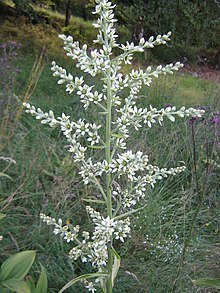Veratrum album
| Veratrum album | |
|---|---|

| |
| Scientific classification | |
| Kingdom: | |
| (unranked): | |
| (unranked): | |
| Order: | |
| Family: | |
| Genus: | |
| Species: | V. album
|
| Binomial name | |
| Veratrum album | |
Veratrum album, commonly known as false helleborine, white hellebore, European white hellebore, white veratrum; syn. Veratrum lobelianum Bernh.[1]), is a poisonous medicinal plant[2][3] of the Liliaceae (lily family) or Melanthiaceae. It is native to Europe.
Plant description
The plant is a perennial herb with a stout vertical rhizome covered with remnants of old leaf sheaths. The stout, simple stems are 50 to 175 cm tall. They have been mistaken for yellow gentian, Gentiana lutea, which is used in beverages, resulting in poisoning.[4][5][6]
Resveratrol has been isolated from the plant.[7][8]
Uses
The root is very poisonous, with a paralyzing effect on the nervous system.[1] In two cases of fatal poisoning from eating the seeds, the toxins veratridine and cevadine were present in the blood. In 1983 sneezing powders produced from the herb in West Germany were reported to have caused severe intoxications in Scandinavia.[9]
History
In 2014 it was claimed that Alexander the Great could have been poisoned by a wine made from Veratrum album.[10][11] Previously it was believed that poisoning due to arsenic or (a mythical belief) the water of the river Styx may have led to the death of the Greek King of Macedon.
In antiquity, an effective emetic based on white hellebore and a bitter oval seed (which Hahneman believed was the seed of Erigeron or Senecio) was mixed by the physicians of Antikyra, a city of Phokis in Greece.[12]


References
- ^ a b Veratrum album at Plants For A Future
- ^ Felter, Harvey Wickes. (1922) The Eclectic Materia Medica, Pharmacology and Therapeutics.
- ^ Felter, Harvey Wickes; Lloyd, John Uri. (1898) King's American Dispensatory.
- ^ Attention: This template ({{cite pmid}}) is deprecated. To cite the publication identified by PMID 15773425, please use {{cite journal}} with
|pmid=15773425instead. - ^ Attention: This template ({{cite pmid}}) is deprecated. To cite the publication identified by PMID 20170391, please use {{cite journal}} with
|pmid=20170391instead. - ^ Verovnik F. (1999). "Naključna zastrupitev z belo čmeriko". Zdravniški Vestnik (in Slovene). 68 (3): 157–160.
{{cite journal}}: Unknown parameter|trans_title=ignored (|trans-title=suggested) (help)CS1 maint: unrecognized language (link) - ^ Delmas, D.; et al. (2006). "Resveratrol as a chemopreventive agent: A promising molecule for fighting cancer" (PDF). Current Drug Targets. 7 (3): 423–442. PMID 16611030.
{{cite journal}}: Explicit use of et al. in:|author=(help) - ^ Takaoka, M., 1939. [Resveratrol, a new phenolic compound, from Veratrum grandiflorum] (Title in Japanese). Nippon Kagaku Kaishi 60, 1090-1100.
- ^ Attention: This template ({{cite pmid}}) is deprecated. To cite the publication identified by PMID 6887310, please use {{cite journal}} with
|pmid=6887310instead. - ^ Schep LJ, Slaughter RJ, Vale JA, Wheatley P (2014). "Was the death of Alexander the Great due to poisoning? Was it Veratrum album?". Clinical Toxicology. 52 (1): 72–7. doi:10.3109/15563650.2013.870341. PMID 24369045.
{{cite journal}}: Unknown parameter|month=ignored (help)CS1 maint: multiple names: authors list (link) - ^ Bennett-Smith, Meredith (14 January 2014). "Was Alexander The Great Poisoned By Toxic Wine?". The Huffington Post. Retrieved 15 January 2014.
- ^ Hahnemann, S. (1852), "A Medical Historical Dissertation on the Helleborism of the Ancients", The Lesser writings of Samuel Hahnemann, William Radde, p. 604, para. 117
External links
![]() Media related to Veratrum album at Wikimedia Commons
Media related to Veratrum album at Wikimedia Commons
